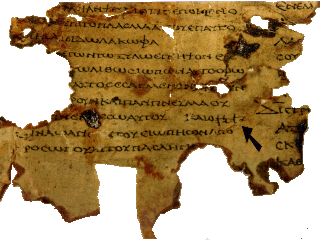 W
WThere have been many Coptic versions of the Bible, including some of the earliest translations into any language. Several different versions were made in the ancient world, with different editions of the Old and New Testament in five of the dialects of Coptic: Bohairic (northern), Fayyumic, Sahidic (southern), Akhmimic and Mesokemic (middle). Biblical books were translated from the Alexandrian Greek version.
 W
WThe Diatessaron is the most prominent early gospel harmony, and was created by Tatian, an Assyrian early Christian apologist and ascetic. Tatian sought to combine all the textual material he found in the four gospels—Matthew, Mark, Luke, and John—into a single coherent narrative of Jesus's life and death. However, and in contradistinction to most later gospel harmonists, Tatian appears not to have been motivated by any aspiration to validate the four separate canonical gospel accounts; or to demonstrate that, as they stood, they could each be shown as being without inconsistency or error.
 W
WThe Gothic Bible or Wulfila Bible is the Christian Bible in the Gothic language spoken by the Eastern Germanic (Gothic) tribes in the early Middle Ages.
 W
WHexapla is the term for a critical edition of the Hebrew Bible in six versions, four of them translated into Greek, preserved only in fragments. It was an immense and complex word-for-word comparison of the original Hebrew Scriptures with the Greek Septuagint translation and with other Greek translations. The term especially and generally applies to the edition of the Old Testament compiled by the theologian and scholar Origen, sometime before 240.
 W
WThe Samaritan Pentateuch, also known as the Samaritan Torah, is a text of the first five books of the Hebrew Bible, written in the Samaritan alphabet and used as scripture by the Samaritans. It constitutes their entire biblical canon.
 W
WThe Greek Old Testament, or Septuagint, is the earliest extant Koine Greek translation of books from the Hebrew Bible, various biblical apocrypha, and deuterocanonical books. The first five books of the Hebrew Bible, known as the Torah or the Pentateuch, were translated in the mid-3rd century BCE; they did not survive as original-translation texts, however, except as rare fragments. The remaining books of the Greek Old Testament are presumably translations of the 2nd century BCE.
 W
WThe Septuagint (LXX), the ancient Alexandrian translation of Jewish scriptures into Koine Greek exists in various manuscript versions.
 W
WSyriac is a dialect of Aramaic. Portions of the Old Testament were written in Aramaic and there are Aramaic phrases in the New Testament. Syriac translations of the New Testament were among the first and date from the 2nd century. The whole Bible was translated by the 5th century. Besides Syriac, there are Bible translations into other Aramaic dialects.
 W
WYemenite scrolls of the Law containing the Five Books of Moses represent one of three authoritative scribal traditions for the transmission of the Torah, the other two being the Ashkenazi and Sephardic traditions that slightly differ. While all three traditions purport to follow the Masoretic traditions of Aaron ben Asher, slight differences between the three major traditions have developed over the years. Biblical texts proofread by ben Asher survive in two extant codices, the latter said to have only been patterned after texts proofread by Ben Asher. The former work, although more precise, was partially lost following its removal from Aleppo in 1947.
 W
WUrtext in biblical studies refers to the assumption that there once was a uniform text of the Hebrew Bible (Tanakh) to precede both the Septuagint (LXX) and the Masoretic Text (MT). Since the 19th century there has been much scholarly work to regain this Urtext. The theory that there was an Urtext was advocated by Paul de Lagarde. Today it is disputed that there ever was such a uniform text.
 W
WVetus Latina, also known as Vetus Itala, Itala ("Italian") and Old Italic, and denoted by the siglum , is the collective name given to the Latin translations of biblical texts that existed before the Vulgate, the Latin translation produced by Jerome in the late 4th century. The Vetus Latina translations continued to be used alongside the Vulgate, but eventually the Vulgate became the standard Latin Bible used by the Catholic Church, especially after the Council of Trent (1545–1563) affirmed the Vulgate translation as authoritative for the text of Scripture. However, the Vetus Latina texts survive in some parts of the liturgy.
 W
WThe Vulgate is a late-4th-century Latin translation of the Bible that was to become the Catholic Church's officially promulgated Latin version of the Bible during the 16th century, and is still used fundamentally in the Latin Church to this day.